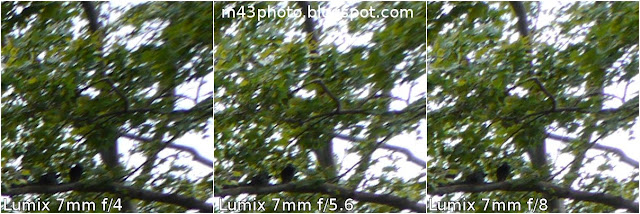Physical
The lens feels heavy, solid and well made. The barrel is made of a plastic material. The zoom ring is rubberized, and rotating it feels smooth and well dampened.
There is no extending zoom tube, but the front element moves when zooming. At 14mm, is is the most retracted into the built in hood, and at 7mm, it is closer to the hood opening.
No filter can be mounted to the front of the lens, and there is no possibility to mount a gelatine filter to the rear side of the lens.
The autofocus is quick and virtually inaudible, due to the internal focus method.
In this short review, I have focused on the lens used at 7mm, where it is the most unique. At longer focal lengths, there are other lenses that overlap.
Example image
This image was taken at 7mm, ISO 160, 1/1300 second, f/4.5, with the Panasonic GH2:
You can notice that there is a significant perspective distortion: The vertical lines are skewed. This is because I was holding the camera non-level (tilted upwards), and does not represent any problem with the lens. It is quite simply a geometrical property.
The sun is inside the image frame (near the Empire State Building), and the lens handles this very well. There is only a minimal amount of flare in the image, and the contrast is still good.
We can take a look at some enlargements (100% crops) from the image, to look at the image quality (click for larger images):
Centre:
Top centre:
Lower right corner:
These crops show us that the sharpness is quite good, although there is some reduction of the sharpness in the extreme image corner.
Sharpness
I have taken some images to look at the sharpness, and compared it with the Samyang 7.5mm f/3.5 fisheye lens (click for larger images).
| Lumix G 7-14mm @ 7mm f/8 | Samyang 7.5mm f/3.5 @ f/8 |
The focus was set on the buildings in the background. To better evaluate the sharpness, here are some 100% crops from the top left corner. The images have not been sharpened, and are from the out of camera JPEG images:
Note that this comparison is not entirely fair. I'm comparing the diagonal corner from the 7-14mm lens, which is at 57°, with the corner from the fisheye lens, which is at 90°. This difference is very substantial.
Here is a comparison from the centre of the image:
In the centre, both lenses render very sharply already from the maximum aperture.
It looks like the camera adds some sharpness to the JPEG images for the Lumix G 7-14mm lens, which is not done for the Samyang lens. This could be because the Samyang lens does not have any electronical contacts, and the camera does not know the nature of the lens.
Here is another test of the Lumix G 7-14mm f/4 lens at 7mm. The full image:
| Lumix G 7-14mm @ 7mm f/8 |
Again, the focus is set on the background. Here are 100% crops from the top right corner:
We see that even when stopping down to f/8, the extreme corner is still unsharp.
In the corners, some Chromatic Aberration (CA) artifacts are retained even when stopping down.
Geometric distortion correction
Like many other Micro Four Thirds lenses, this lens requires in-camera software correction to become rectilinear. However, the adjustments done at 7mm are fairly small. Here is an illustration of the example image with and without the distortion correction. One could conceivably use the output image without the geometric distortion correction, which would yield an even wider perspective.
Conclusion
The Lumix G 7-14mm f/4 ultra wide lens is a very good, and expensive lens. It is a joy to use, and handles flare well. The extreme corners are a bit dull at the widest setting, but this is probably not a big deal with real life usage of the lens.
At the moment, this is the widest rectilinear lens available for the Micro Four Thirds format.












I *love* this lens. A good percentage of my favorite shots that I've taken were at 7mm with this one. Pairs really well with an articulating screen for great low-angle shots.
ReplyDeleteI wish you compared it with the Olympus 9-18mm f/4-5.6.
ReplyDeleteMainly on the distortions level.
Do we get this distortion correction in ACR as well?
I don't have the Olympus M.Zuiko 9-18mm lens, so I cannot do that comparison.
DeleteThanks for such a informative blog. I'm still trying to figure out how to get a full circular fish eye effect on a micro 4/3 sensor? Is that even possible?
ReplyDeleteThe Sigma 4.5mm f/2.8 has an image circle which is suitable for Micro Four Thirds. So it will give a full circle fisheye on M4/3. But you need an adapter as well.
DeleteAlso, there are some very expensive options from the company Entaniya.